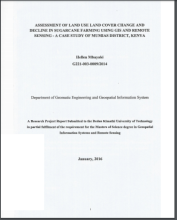Land Library
Welcome to the Land Portal Library. Explore our vast collection of open-access resources (over 74,000) including reports, journal articles, research papers, peer-reviewed publications, legal documents, videos and much more.
/ library resources
Showing items 1 through 9 of 67.Matters of environmental migration are frequently looked at from a humanitarian perspective.1 This policy brief will instead look at it with a lens focusing on land issues. The question of environmental migration is inevitably linked to the question of land for several reasons.
Land use/cover changes are pervasive with no clear understanding of their spatial extends, drivers and impacts to society. Land-use changes have become a key component in the current strategies for managing and monitoring the natural resources and environment changes.
Land uses are changing rapidly in Vietnam’s upland northern borderlands. Regional development platforms such as the Greater Mekong Subregion, state-propelled market integration and reforestation programs, and lowland entrepreneurs and migrants are all impacting this frontier landscape.
While geographers and economists regularly work together on the development of land-use and land-cover change models, research on how differences in their modelling approaches affects the results is rare.
Madagascar is renowned for the loss of the forested habitat of lemurs and other species endemic to the island. Less well known is that in the highlands, a region often described as an environmental “basket-case” of fire-degraded, eroded grasslands, woody cover has been increasing for decades.
The Californian Floristic Province, ranging from Northern California, USA, to the northwestern portion of the state of Baja California, Mexico, is a region of great biological richness that has a high risk of loss of species due to the effect of human activities.
Illegal occupation of argan forest parcels by local households is a new phenomenon in South West Morocco. This is primarily due to the weakening of traditional common control systems and to the boom of the argan oil price.
Wind-power development in the U.S. occurs primarily on private land, producing royalties for landowners through private contracts with wind-farm operators. Texas, the U.S.
This paper seeks to understand the drivers and pathways of local livelihood change and the prospects for transformation towards a more sustainable future.



